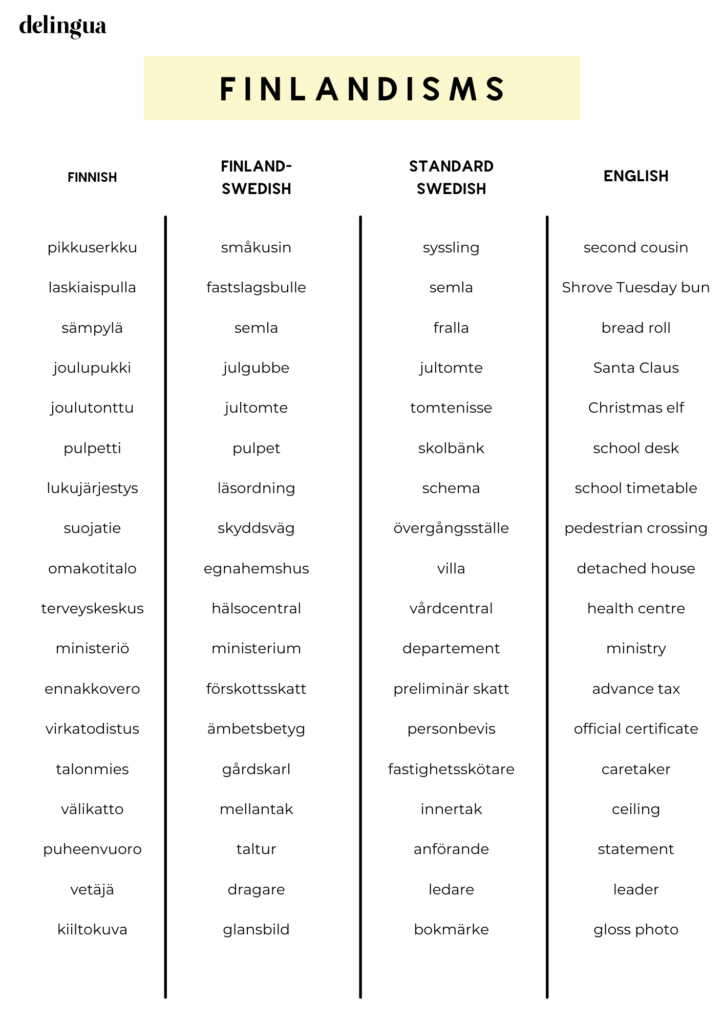Swedish has been spoken in Finland for centuries and, over time, it has developed into a variant called Finland Swedish, or Finnish-Swedish or Fenno-Swedish. Finland Swedish is most commonly spoken on the coast of Ostrobothnia, in the Åland Islands, in the Turku archipelago and in Uusimaa. The main differences between Finland Swedish and Standard Swedish are to do with pronunciation, but there are also some words and phrases that only exist in Finland Swedish. This sometimes leads to discussion of the possibility that Finland Swedish should be regarded as a language of its own. However, as speakers of Finland Swedish and Standard Swedish understand one another, Finland Swedish has not been categorised as a separate language but as one of the variants of Swedish. In fact, one of the goals of the custodians of Finland Swedish is to ensure that the Swedish spoken in Finland retains the features it shares with Standard Swedish.
Pronunciation
The major differences between Finland Swedish and Standard Swedish are to do with pronunciation. It only takes a few words to notice whether a person is speaking Finland Swedish or Standard Swedish. Finland Swedish is pronounced very much like Finnish, whereas Standard Swedish is much more melodic. However, it is important to remember that the pronunciation of Standard Swedish also varies between different regions of Sweden, and there are also different dialects of Finland Swedish.
One of the most obvious differences is that Swedish-speaking Finns usually pronounce all the letters of a word, while Swedes have a habit of merging the sounds. For example, this is evident in a word like djur (‘animal’). Swedish-speaking Finns pronounce it [dju:r], whereas Swedes pronounce it [ju:r].
Sentence construction
The Finnish language also affects the sentence structure of Finland Swedish, even though the grammar is almost identical. The impact of Finnish is particularly evident in the use of prepositions. The Finnish language uses grammatical cases instead of prepositions, which is why bilingual Swedish-speaking Finns in particular may have a hard time with Swedish prepositions.
For example, the Swedish från (‘from’) is replaced in Finnish by the suffix -sta or -stä, and the Swedish i (‘in’) is replaced by -ssa or -ssä. Therefore, where Finnish speakers would say ostaa kaupasta (‘buy from the store’), it would not translate into the Swedish köpa från en affär, but köpa på en affär. However, some ‘incorrect’ expressions are accepted in Finland Swedish. For example, vahingossa (‘by mistake’, which directly translates as ‘in mistake’) is av misstag in Standard Swedish, but Finland Swedish also accepts i misstag.
Finlandisms
Finlandisms are words and expressions only used in Finland Swedish. They reflect Finnish society and culture and may not have an equivalent term in Standard Swedish. Words not found in Standard Swedish include samkommun=kuntayhtymä (‘local government regional authority’), abiturient=abiturientti (‘candidate for the matriculation examination’) and medborgarinstitut= kansalaisopisto (‘adult education centre’). Finlandisms are an easy way to spot Finland Swedish. The table presents other Finlandisms with their counterparts in Standard Swedish. However, Finlandisms do not mean that the equivalent Standard Swedish term could not be used by a Swedish-speaking Finn.

